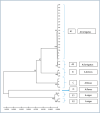Molecular epidemiology and antifungal susceptibilities of Aspergillus species isolated from patients with invasive aspergillosis
- PMID: 36820712
- PMCID: PMC9937602
- DOI: 10.1590/1806-9282.20220441
Molecular epidemiology and antifungal susceptibilities of Aspergillus species isolated from patients with invasive aspergillosis
Abstract
Objective: The aim of this study was to evaluate the demographic data, molecular epidemiology, and in vitro antifungal susceptibility results of patients with Aspergillus isolated from various clinical specimens.
Methods: A total of 44 Aspergillus strains were studied. The definition of invasive aspergillosis in patients was made according to European Organization for Research and Treatment of Cancer/Invasive Fungal Infections Cooperative Group and the National Institute of Allergy and Infectious Diseases Mycoses Study Group (EORTC/MSG) criteria. Strains were phenotypically and molecularly identified. Demographic characteristics of patients and genotypes of strains were evaluated. Phylogenetic analysis was done by the The Unweighted Pair-Group Method with Arithmetic Mean (UPGMA). Antifungal susceptibility of strains was determined according to The Clinical and Laboratory Standards Institute (CLSI)-M61-Ed2 and The European Committee on Antimicrobial Susceptibility Testing (EUCAST).
Results: A total of 11 patients were classified as proven and 33 as probable invasive aspergillosis. There was a statistically significant difference in age groups, subdisease, neutropenic, and receiving chemotherapy between groups. A total of 23 strains were identified as Aspergillus fumigatus, 12 as Aspergillus niger, 6 as Aspergillus flavus, and 3 as Aspergillus terreus. Phylogenetic analysis revealed five different genotypes. No statistical difference was found in the comparisons between patients groups and genotype groups. There was a statistically significant difference between genotype groups and voriconazole, posaconazole, and itraconazole Minimum Inhibition Concentration (MIC).
Conclusion: Accurate identification of strains and antifungal susceptibility studies should be performed due to azole and amphotericin B resistance. Genotyping studies are important in infection control due to identifying sources of infection and transmission routes.
Conflict of interest statement
Conflicts of interest: the authors declare there is no conflicts of interest.
Figures

References
-
- Donnelly JP, Chen SC, Kauffman CA, Steinbach WJ, Baddley JW, Verweij PE, et al. Revision and update of the consensus definitions of invasive fungal disease from the European Organization for Research and Treatment of Cancer and the Mycoses Study Group Education and Research Consortium. Clin Infect Dis. 2020;71(6):1367–1376. doi: 10.1093/cid/ciz1008. - DOI - PMC - PubMed
-
- de Valk HA, Meis JFGM, de Pauw BE, Donnelly PJ, Klaassen CHW. Comparison of two highly discriminatory molecular fingerprinting assays for analysis of multiple Aspergillus fumigatus isolates from patients with invasive aspergillosis. J Clin Microbiol. 2007;45(5):1415–1419. doi: 10.1128/JCM.02423-06. - DOI - PMC - PubMed
MeSH terms
Substances
LinkOut - more resources
Full Text Sources
Medical

